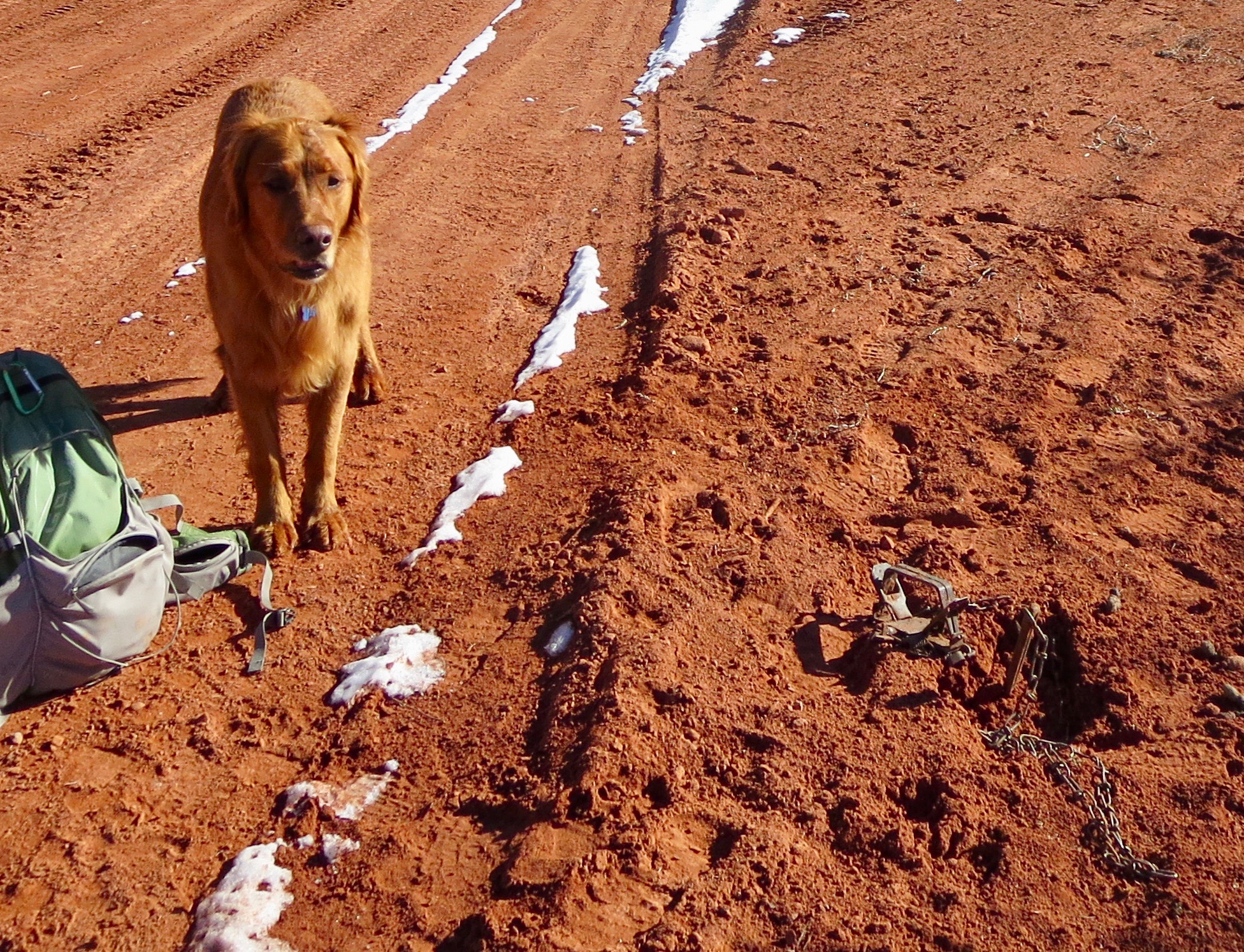

EMAIL YOUR COMMENTS ON THIS ISSUE BY JUNE 4, 2021
About this TAKE ACTION
Over the last several months, the Wyoming Game and Fish Department (WGFD) reevaluated its current trapping regulations using an intensive public participation process. As a result, recommendations for changes to trapping regulation are going to a final vote and possibly into effect in July 2021.
Recommended changes focus on Wildlife Habitat Management Areas (WHMA) and one Public Access Area (John/Annie Woodhouse). Even if these recommendations are adopted in July 2021, they fail to address the majority of trapping dangers facing you, your family, and our wildlife. Your opinion matters. You could save lives. Please share your public comment today.
The WGFD is accepting public comment through June 4, 2021. The WGF Commission will vote to accept the recommendations or not, or recommend and approve additional regulation changes on July 13-14, 2021 in Sheridan, WY. The details are provided below.
Trapping reform is underway. But more progress is necessary. We Need Your voice!
Trapping Reform is Inching Forward
Wyoming Game and Fish Department has proposed five trapping regulation changes for public comment, but recommendations are far from protecting our pets and wildlife on our public landscapes.
Although Wyoming Untrapped petitioned the Commission to designate trap-free zones in high-use areas statewide and ban the deadly Senneker snare, these requests were not included.
The WGFD has the authority to regulate furbearer trapping in areas with a high potential for conflict between trappers and non-trappers, including campgrounds, boat ramps, picnic areas, and trailheads, they have chosen not to take action. View WGFD Draft Regulation.
Because predatory trapping is legal in these areas, WGFD stated “Designating areas where furbearer trapping is not permissible and predator trapping is allowed creates an unenforceable situation and unmet expectations.”
The Commission can vote any way they see fit, including declining all regulation changes. They are not required to consider the fact that the Commission directed the Department to gather information via public participation sessions over 8 months. Your public comment made through June 4, 2021 will be included in the Commissioner’s meeting packets.
These small recommendations mostly for WHMA’s and during short pheasant hunt seasons are a step forward, but our pets and wildlife are STILL vulnerable to danger! Your letters, phone calls, conversations, and comments have moved us to this point, but now need to speak louder!
To submit public comment, deadline is Friday, June 4, 5pm.
Scroll down to: Chapter 4, Furbearing Animal Hunting or Trapping Seasons.
Then Submit Online Comment.
These meetings will be held in person or virtually. To participate via ZOOM you must register. (see virtual presentation links below). We are asking for the Wyoming public to plan to attend a public meeting in person or the virtual option if available.
Chapter 4 – Trapping Reform
Chapter 47 – Wolves
**Note: In-person meetings will not be available in our home base of Jackson.
| Date | Time | City | Location | Chapters |
| April 28, 2021 | 5:00 p.m. | Cody | Park County Library | 22, 46 |
| May 5, 2021 | 6:00 p.m. | Laramie | Game and Fish Office | 4, 47 |
| May 11, 2021 | 6:00 p.m. | Lander | Game and Fish Office & Virtual Presentation | 47 |
| May 13, 2021 | 6:00 p.m. | Pinedale | Game and Fish Office | 4, 47 |
| May 18, 2021 | 6:00 p.m. | Casper | Game and Fish Office | 4, 22, 47 |
| May 18, 2021 | 6:00 p.m. | Green River | Virtual Presentation | 22, 46 |
| May 18, 2021 | 6:00 p.m. | Jackson | Virtual Presentation | 47 |
| May 19, 2021 | 6:00 p.m. | Jackson | Virtual Presentation | 4 |
| May 20, 2021 | 6:00 p.m. | Green River | Game and Fish Office | 4, 47 |
| May 20, 2021 | 7:00 p.m. | Lander | Game and Fish Office & Virtual Presentation | 4, 22, 46 |
| May 20, 2021 | 5:30 p.m. | Sheridan | Game and Fish Office | 4, 47 |
| May 21, 2021 | 6:00 p.m. | Cody | Park County Library | 4, 47 |
Virtual Presentation Links
Click here to view Lander Region May 11, 2021 virtual presentation on Gray Wolf Hunting Seasons
Click here to view Jackson Region May 18, 2021 virtual presentation on Gray Wolf Hunting Seasons
Click here to view Jackson Region May 19, 2021 virtual presentation on Trapping Seasons
Click here to view Lander Region May 20, 2021 virtual presentation on Trapping, Watercraft and Fishing Regulations
Mail Comment to:
Wyoming Game and Fish Department
Wildlife Division
Attn: Regulations
3030 Energy Lane
Casper WY 82604
TAKE ACTION
Deadline: June 4, 2021, 5 pm
ZOOM registration directions TBA.
PUBLIC COMMENTS AT THE MEETING.
CONTACT EMAIL:
Wyoming Game and Fish Department
- Director Brian Nesvik, brian.nesvik@wyo.gov (307-631-1845)
- Rick King, richard.king@wyo.gov (307-777-4684)
Chief, Wildlife Division - Jason Hunter, jason.hunter@wyo.gov Lander WGFD (307-335-2609)
Lander Region wildlife supervisor and lead of the internal working group - Scott Edberg, scott.edberg@wyo.gov
- Brad Hovinga, brad.hovinga@wyo.gov
Teton County, (307-733-2321) - Sheridan Todd, sheridan.todd@wyo.gov (Director’s office)
307-777-4501
Wyoming Game and Fish Commission
- President Peter J. Dube, peter.dube@wyo.gov
Sheridan, Johnson, and Campbell Counties - Gay Lynn Byrd, gaylynn.byrd@wyo.gov
Converse, Natrona, Fremont - Ralph Brokaw, ralph.brokaw@wyo.gov
Sweetwater, Carbon, and Albany Counties - Richard Ladwig, richard.ladwig@wyo.gov
Crook, Weston, and Niobrara Counties - Kenneth Roberts, kenneth.roberts@wyo.gov
Teton, Sublette, Lincoln, and Uinta Counties - Ashlee Lundvall, ashlee.lundvall@wyo.gov
Park, Big Horn, Hot Springs,
and Washakie Counties - Mark Jolovich, mark.jolovich@wyo.gov
Platte, Goshen, and Laramie Counties
Governor Mark Gordon
- Governor Mark Gordon, governor@wyo.gov (307-777-7434)
- Joe Budd, joe.budd@wyo.gov (307-777-7434)
WYOMING Legislators: 2021 TRW Committee Members. If you know your legislators, please let them know how you feel about trapping and snaring. Thank you!
Meanwhile, animal injuries and death continue!
The incidental trapping of pets resulting in injuries and death continues to increase on our public lands. In the wake of these tragedies, current WGFD regulations leave recreationists believing that there is no or little accountability in the sport of trapping and that there is “no safe place for recreationists in Wyoming.” This dynamic is bad for trapping and bad for Wyoming.
STATEMENT OF REASONS
The department will host public meetings and provide virtual presentations
for the regulations below:
STATEMENT OF REASONS
WYOMING GAME AND FISH COMMISSION
CHAPTER 4
FURBEARING ANIMAL HUNTING OR TRAPPING SEASONS
W.S. § 23-1-302(a)(i) directs and empowers the Commission to fix seasons and bag
limits, open, shorten or close seasons on any species or sex of wildlife except predatory
animals, predacious birds, protected animals and protected birds.
W.S. § 23-2-303 provides for the trapping of furbearing animals, license
requirements to trap, tagging requirements for traps, types of traps and time periods for
checking traps.
Section 2. The term “Power Activated Snare” is being defined to differentiate
certain types of snares and associated devices from other snares.
(f) “Power-Activated Snare” means a snare with a spring or other device that applies
pressure to the locking mechanism.
Section 4. The Rawhide Wildlife Management Area, Springer Wildlife Habitat
Management Area and the Table Mountain Wildlife Habitat Management Area are being
removed from the list of areas closed to the taking of all furbearing animals. These same
areas are being included in a new subsection (b)(v) limiting the use of any snare or quick-kill
body grip trap with a jaw spread exceeding five (5) inches on these areas from October
1 through February 15.
Section 4 (b)(v) The following areas shall be closed to the use of any snare or quick-kill
body grip trap with a jaw spread exceeding five (5) inches from October 1 through February 15;
(A) Rawhide Wildlife Habitat Management Area;
(B) Springer/Bump Sullivan Wildlife Habitat Management Area; and,
(C) Table Mountain Wildlife Habitat Management Area.
In new subsections (b)(iv) and (v) the Commission is proposing to limit the use of
any snare or quick-kill body grip trap with a jaw spread exceeding five (5) inches on certain
Wildlife Habitat Management Areas (WHMA) during specified times of the year to
decrease potential for unintended catches.
Section 4 (b)(iv) The following areas shall be closed to the use of any snare or quick-kill
body grip trap with a jaw spread exceeding five (5) inches during any open pheasant hunting
season:
(A) Bud Love Wildlife Habitat Management Area;
(B) Ocean Lake Wildlife Habitat Management Area;
(C) Sand Mesa Wildlife Habitat Management Area east of Bass Lake Road;
(D) Yellowtail Wildlife Habitat Management Area.
Section 4 (b)(v) The following areas shall be closed to the use of any snare or quick-kill body grip trap with a jaw spread exceeding five (5) inches from October 1 through February 15;
(A) Rawhide Wildlife Habitat Management Area;
(B) Springer/Bump Sullivan Wildlife Habitat Management Area; and,
(C) Table Mountain Wildlife Habitat Management Area.
In new subsection (b)(vi) the Commission is proposing to designate two areas
administered by the Department as closed to the use of any snare, quick-kill body grip trap,
leg-hold trap or live trap due to agreements entered into by the Department to manage these
areas.
Section 4 (b)(vi) The following areas shall be closed to the use of any snare, quick-kill body grip trap, leg-hold trap, and live trap during the calendar year;
(A) Pilot Hill Wildlife Habitat Management Area; and,
(B) John/Annie Woodhouse Public Access Area.
Section 8. A new subsection (e) is being created to regulate the use of certain power
activated snares on public lands. A power-activated snare with a spring greater than three
(3) inches in length when fully extended may only be set on private land. Power-activated
snares with springs greater than three (3) inches in length are rarely used on public land.
Section 8 (e) Power-activated snares with a spring greater than three (3) inches in length when
fully extended may only be set on private land; and,
WYOMING UNTRAPPED REQUESTED Trapping Reform LIST
Furbearer trapping regulations in the coming year will be adjusted and updated by the Wyoming Game and Fish Commission. WU has in the past, and continues to, assert that the following trapping regulation changes are necessary. Please stay tuned as we work through the process to create a safe and humane environment on our public lands.
- Trap Free Areas (Legislature and/or Commission) – Ask for trap-free areas for heavily used public recreation areas in Teton County, Fremont County and statewide. Access to trap free lands is a public right.
- 24–Hour Trap Checks ( Legislature) – Support of 24-hour trap checks statewide by writing your state representatives. Changing this law will require action by the Wyoming State Legislature. Wyoming is one of fourteen states that have not addressed the need for 24-hour trap checks. Wyoming state law currently requires a 72-hour check for leg hold traps and up to 13 days for snares and quick kill traps. Long trap check cycles result in suffering, pain, dehydration, starvation and loss of litters when a female/mother is trapped. For family pets that have been trapped, a 24-hour trap check could mean the difference between life and death.
- Trap Set Backs (Commission) – Trap setbacks of 300 feet off of busy public trails statewide. The public has a right to safe travel on trails, this right extends to their traveling companions, including dogs and livestock.
- Mandatory Signage (Legislature) – Caution signs, warning recreationalist, hunters, anglers and non-consumptive users of the dangers of trapping and specific trap placement on public lands, should be a mandatory requirement.
- Mandatory Reporting – Non Target and Pets (Legislature) – Reporting of all non-target species trapped and/or killed, including pets. Trappers and the Wyoming Game and Fish would argue that trapping is a management tool. Without mandatory reporting there is no data, without data there is no management.
- Mandatory Reporting – All Species (Legislature) – Reporting of all species trapped. See above. Trappers and the Wyoming Game and Fish would argue that trapping is a management tool. Without mandatory reporting there is no data, without data there is no management.
- Mandatory Trapper Education (Legislature) – Mandatory trapper education should be a requirement. Idaho’s mandatory Trapper Education Law went into effect July 1, 2018. This law requires first time trappers to complete a Trapper Education Course before purchasing a license. The class is designed to teach trappers how to “minimize impact on others” as well as best practices to avoid trapping, injuring and killing non-target animals. Wyoming is lagging behind our neighboring states on trap reform that would make our public lands safer for all.
- Ban of all trigger-loaded Power snares and Senneker snares (Legislature and/or Commission)– Power Snares and Senneker snares are extremely lethal, non-target species including pets are killed almost instantly. These traps should not be allowed on Wyoming’s landscape.
- Mandatory Conservation Stamp Purchase (Legislature) – “Funds from the conservation stamp purchase are used to support habitat and wildlife projects in Wyoming”. (Quote from WG&F website) Anglers and Hunters are required to purchase a Conservation Stamp, trappers are not. Trappers, who use the public’s wildlife for economic gain, should, more than any other user, be required to purchase a Conservation Stamp.
- Live Traps (Commission) – Live traps should be used wherever and whenever possible. Live traps would ensure that non target species, including protected and endangered species, can be released unharmed. Snares, leg hold, Conibear, Senneker and Power Snares are non-discriminate, they kill and maim regardless of species and protection status.
- Require all traps and snares to be removed at the end of trapping season (Legislature) – Thousands of traps and snares are left behind on our public landscapes at the end of trapping season. Some remain active. Trappers should be responsible for cleaning up all litter and hazards which they have placed on the land.
- Initiate statewide trapping reform stakeholder task force ( Legislature) – Trapping reform awareness statewide is growing rapidly which is initiating more public involvement and demand for immediate change.
- Review furbearer trapping regulations every two years ( Legislature) – Trapping regulations are scheduled for review on a three-year time frame. However, hunting and fishing are reviewed every two years.
Talking Points
Original words directly from your own heart and mind are more likely to be given consideration than words and phrases that sound scripted. See the take-action box above to email your comments to Jason Hunter, Lander Region wildlife supervisor and lead of the internal working group: jason.hunter@wyo.gov. If you prefer a personal connection with your Commissioner, feel free to call or email directly. Thank you!
WHY TRAPPING REFORM IS URGENT IN 2021
- The Legislators, WGF Commission, and WGF Department are our wildlife management leaders.
The failure to respond to the increase of land-use conflicts across Wyoming perpetuates land-use conflict. At the Lander WGFD workshop participants were reminded to be responsible land users and that their pets’ welfare is the sole responsibility of their owners. Blaming grieving residents for failure to see and avoid hidden lethal traps on public lands is ridiculous. We know Wyoming can do better and ask you to please step up and lead. - The department’s new strategic plan has several goals for conserving wildlife and serving people that include:
- Enhance safety for those living, working, and recreating around wildlife and on Wyoming’s waterways.
- Promote quality and diverse fish and wildlife-based experiences other than hunting, fishing, and trapping.
- Enhance the department’s ability to quantify and utilize public input when making management decisions
If enhanced safety is a goal, why doesn’t the department want to post trapping warning signs that clearly outline the risks and the trapping season dates, this information is clearly displayed can prevent injuries and prompt awareness for recreationalist?
If the department has goals of safety, promotion of non-consumptive activities/users, and enhancement utilization of public input, then why not provide trap-free zones in documented high use areas, and requiring setbacks on any designated/established trails when petitioned to do so?
- WU is asking for the ban of all power-activated snares like the one that killed “Mac” in Fremont County in January 2020. Our request compares any mechanical advantage assisted snare to the dangerous large-size body grip traps, 330 conibears. The same non-selectivity and the same lethality. Dogs, cats, nontarget raptors, and game animals and livestock will be more seriously injured or killed by these snares. The trappers can argue that the time until the death of their target adult prime coyotes or bobcats will be reduced – – – but their ability to release young or non-target animals ( including domestic dogs) will be gone. And your ability to release your own dog while hiking or hunting before it suffocates will be reduced. These mechanically advantaged snares should be prohibited. However, WGFD states that the deadly Senneker snare “is more humane than the normal snares and will remain legal.” We believe this is an unconscionable response to a deadly problem on our public landscapes.
- The Boone and Crockett Club, an organization that advocates for fair chase hunting, does not consider the use of snare traps to fall under the umbrella of fair chase, for example, says Justin Spring, director of big game records at the organization. Wildlife advocates view snares as fundamentally inhumane because it can take hours or even days for wolves to die “a slow, agonizing death,” says Stephen Capra, director of Footloose Montana, a nonprofit organization that seeks to end trapping in the state. “It’s nothing but indiscriminate killing,” he says, noting that snares have been documented to capture and kill non-target species including mountain lions and pet dogs.”
- On behalf of Wyoming Untrapped, Mac, and the citizens of Wyoming, please consider restricting the use of ALL power snares on public lands, such as the Senneker spring snare or quick-kill snares, as soon as possible. However, the WGFD response is that the “Senneker is a more humane snare than the normal snares” and will remain legal.
- The incidental trapping of pets resulting in injuries and death continues to increase on our public lands. In the wake of these tragedies, current WGFD regulations leave recreationists believing that there is no or little accountability in the sport of trapping and that there is “no safe place for recreationists in Wyoming.” This dynamic is bad for the sport of trapping and bad for Wyoming.
- Over the last several years, WU has recorded 80+ reported dog trapping incidents in Wyoming. Ten of these died. Seven of the 80+ incidents were in Teton County. There could be many more out there, but no official record exists. Just recently, two trapping incidents took place in a week. Just a couple of days before the Christmas 2019 holiday, a dangerous trapline was set in the Cache Creek area adjacent to the town. In this case, the trapper was cited for two violations and appeared in the Teton County court. A few days later, on January 4, 2020, a beloved pet, “Mac,” was caught in a lethal power snare and died within two minutes in the arms of Karen Zoller on public land in Fremont County. When WU asked for action on Mac’s case, some of the WGFD staff had never heard of these new snares, increasing the danger on our public lands. Emotions are high, and Wyoming residents are now reaching out to you and their electeds.
- We are disappointed in the Wyoming Game and Fish Department’s (WGFD) decision to ignore citizen’s concerns about safety entirely. The request for warning signage and trap setbacks on high-use trails, and trap-free areas with high public use are completely ignored. Now trappers can place traps and snares almost anywhere on public lands, including in the middle of a hiking trail. When WGFD recommends changes that apply mostly to Wildlife Habitat Management Areas (WHMA) to protect hunting dogs, but does not address the same protections for the remainder of the public lands, this double standard leaves all other pet owners, their dogs, and wildlife still vulnerable to trap injuries and death. As you know, the incidents of accidental trapping of pets or “close calls” continue to be reported and discussed by the public.
- Our understanding is that big game hunting areas and fishing regulations are managed with an annual scientific evaluation of data and information collected from hunters, fishermen, landowners, and the public to determine specific needs for maintaining healthy populations in each hunting and fishing area. Factors considered may include numbers of wildlife in an area, drought conditions, loss of habitat, disease, etc. The same diligence should be applied to fur trapping. There does not appear to be required reporting of all species trapped regardless if they are targeted species, non-target species or someone’s pets. This is not using best practices science available to determine trapping areas’ annual harvest quotas. We suggest that the Wyoming Game and Fish Commission determine allowable fur trapping harvests based on science and documentation of species trapped.
- The continued lack of respect for public outdoor safety is obvious. The failure of the Wyoming Game and Fish Department to address the majority of trapping dangers facing our families, and our wildlife is dangerous. We don’t have a population count on our state furbearers, but we allow unlimited quotas. A department with the duty to make scientific-based decisions cannot manage wildlife effectively without data.
- To avoid future incidents, we propose the establishment of criteria to guide trapping closures on “highly used public recreation areas” statewide, Beginning with areas that have documented conflict histories, such as Teton County, Fremont County, Park County, and the towns Laramie, Pinedale, and Rock Springs. Examples of “a highly used public area” in Teton County are Cache Creek, Game Creek, Old Pass Road, Snow King Trail Network, Teton Canyon, and Darby Canyon. Today, the overall use of the Cache Creek trail system continues to rise and is estimated as high as 1526 daily, with an annual average of 400 people per day per a trail counter data summary 2019. GIS maps of these areas show the trail count numbers and the need for trapping closures. Overall Map.
- Additional areas statewide seeking closures are:
- Fremont County: Sinks Canyon trail system including the Pete’s Lake Trail, Brewers Trail, Stock Bypass Trail, and the Middle Fork Trail to Popo Agie Falls, Bus Loop Trail System, Johnny Behind the Rocks Trail System, Wild Iris Climbing Area, Beaver Creek Nordic Ski Area, and Hiking Trails, Red Canyon, including USFS, BLM, and WG&F Wildlife Management Area, Ocean Lake Wildlife Habitat Management Area, and Mesa Wildlife Habitat Management Area.
- Albany County: Happy Jack Recreational Area and Vedauwoo Recreational Area near Laramie, WY.
- Park County: Newton Lake area, Twisted Sister, the McCullough Peaks Rd, the Shoshone river trail is from the Paul Stock area all through the river’s edge until it ends.
- Sublette County: Soda, Fremont and Halfmoon Lakes, which include campgrounds. State Land near the New Fork River
- The right to be informed and safe on public lands.
Warning signs should be required in areas where there are traps and snares to increase public safety. Traps are legal on all public trails where dogs can be walked. There should be 300 ft setbacks off trails, or trap-free areas where anyone can have a reasonable expectation of safety on our public lands. Trappers should be accountable for injuries or death to your pet. - Unacceptable deaths and severe injuries to non-target species; even animals released alive may later die from their injuries.
We don’t know how many non-target animals are trapped/snared, injured, or killed in traps each year. All of the ~thousands of non-target animals should be required reporting by trappers. - Please consider the following trapping reform:
Trap-free areas for heavily used public recreation areas statewide, required signage where traps and snares are present, reporting of all species trapped, a ban of the new deadly trigger-loaded power snare and Senneker snare, reporting of all non-target species trapped and/or killed, including pets, trap setbacks of 500 feet off of busy public trails statewide, required the purchase of Conservation Stamp for all trappers, use of live traps whenever possible, mandatory trapper education, and support of 24-hour trap checks statewide. - It’s time for Wyoming’s wildlife decision-makers to diversify its perspective and work with all stakeholders to fund wildlife conservation. Fortunately, wildlife advocates are making it clear that they, too, must have a say in decisions that affect the wildlife held in trust for all Americans. We are speaking up in wildlife commission meetings, petitioning for more protections for wildlife from cruel and unsporting practices, and urging their state governors to appoint more wildlife-friendly members to commissions.
- Our trapping reform list is long, but we, and other state advocates, will continue to promote as top priorities: Trap free areas on highly recreated public trails, trap and snare setbacks from all public trails, and mandatory reporting of all domestic and wild non-target animals. 24-hour trap checks for all traps and snares are urgent.
- The overall management of trapping is not cost-effective. A furbearer trapping license costs $45 for all you can catch. How can that be cost-effective for our state? Perhaps one license should be required for each furbearer species and a limited quota. WU has submitted a WPRA request for WGFD furbearer management plan, full cost-benefit analysis studies, annual reports, and population data, including all impacts: biology, ecology, aesthetics, safety, ethics, economy. We are currently waiting for a response.
- There are emerging trends in national wildlife management. We value and protect wildlife as vital contributors to the health of our public landscapes and for the intrinsic character and worth of all furbearing animals. We value the significant impact of wildlife watching on tourism – Wyoming’s 2nd largest industry. Wyoming’s wildlife management is not keeping pace with our modern society’s views.
- Wildlife management should better represent the values of all citizens. Our wildlife is a public treasure owned equally by all citizens and taxpayers. Therefore, it is not just that a few people are allowed to indiscriminately trap and kill this wildlife. Trapping and snaring greatly reduces the number of animals and thus the number of wildlife sightings for the public – depriving them of much pleasure.
- Trapping lost its charm long ago as a Wyoming tradition, let alone an American one. A growing debate about the legitimacy of trapping shows that a shift is here. Every step is breaking new ground. Trapping for fun, trophies, fur, and feeding one’s ego is no longer acceptable by a growing modern population.

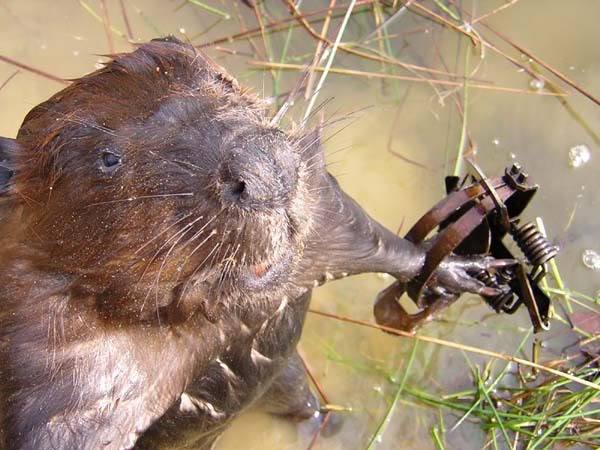




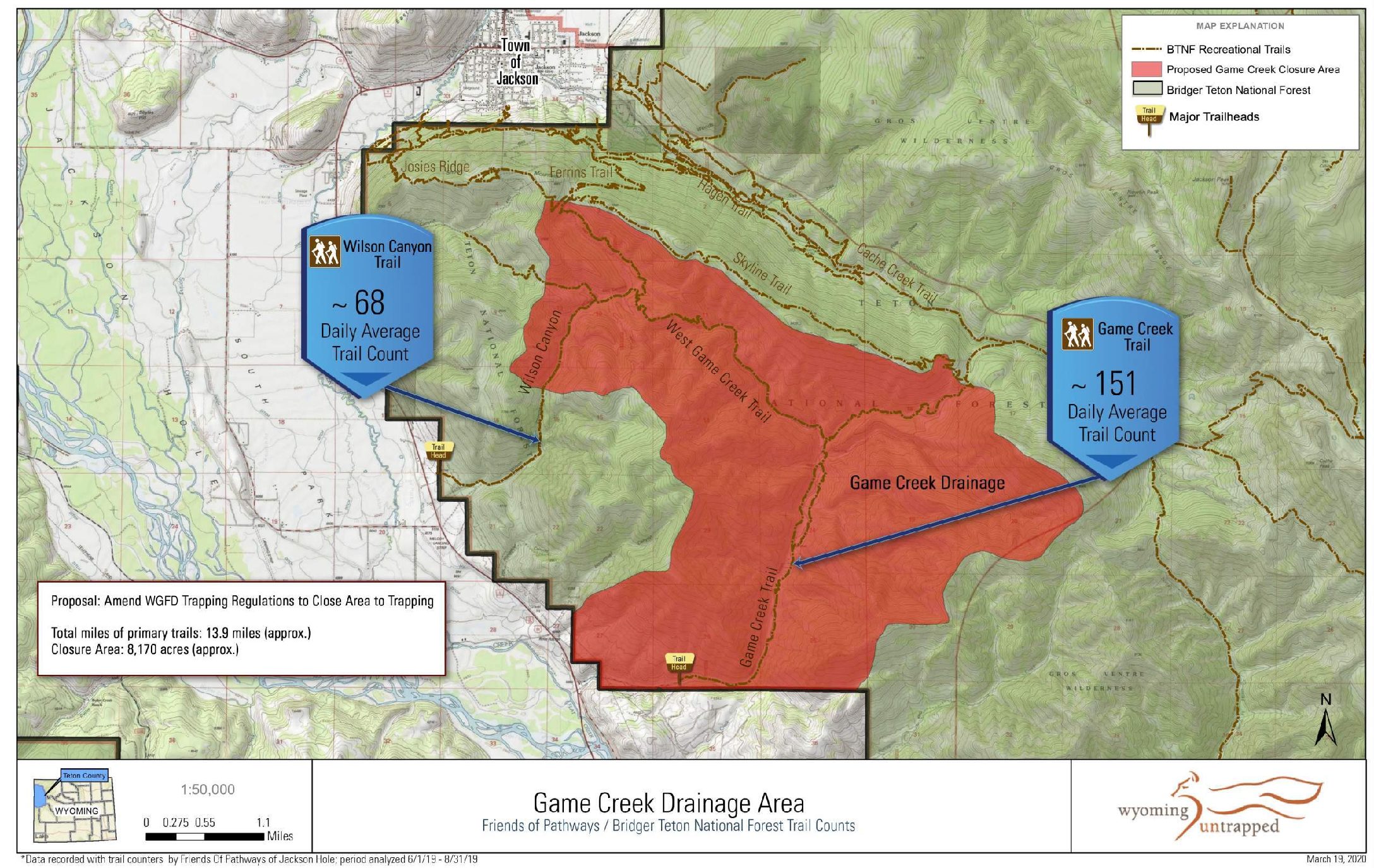

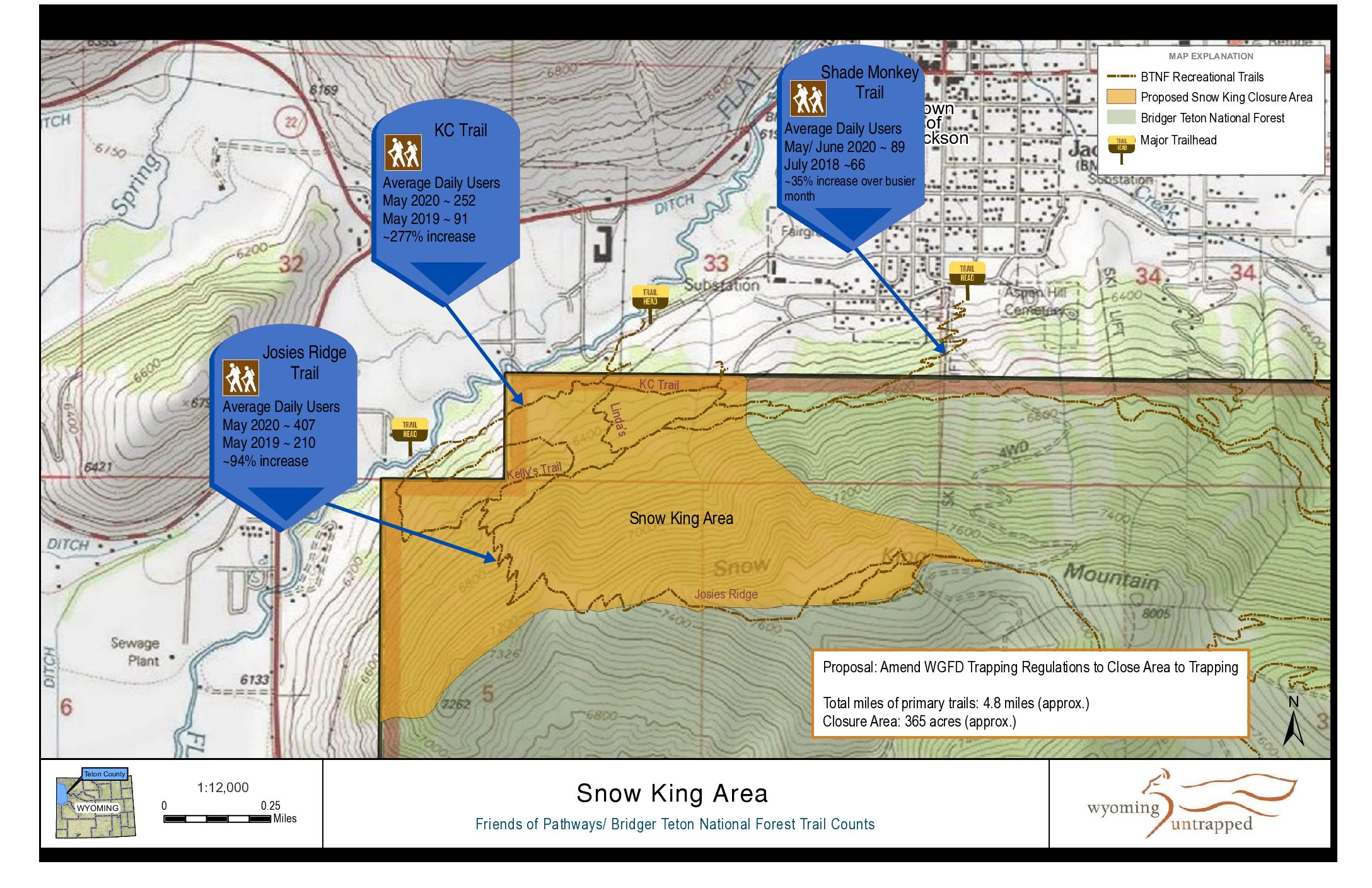
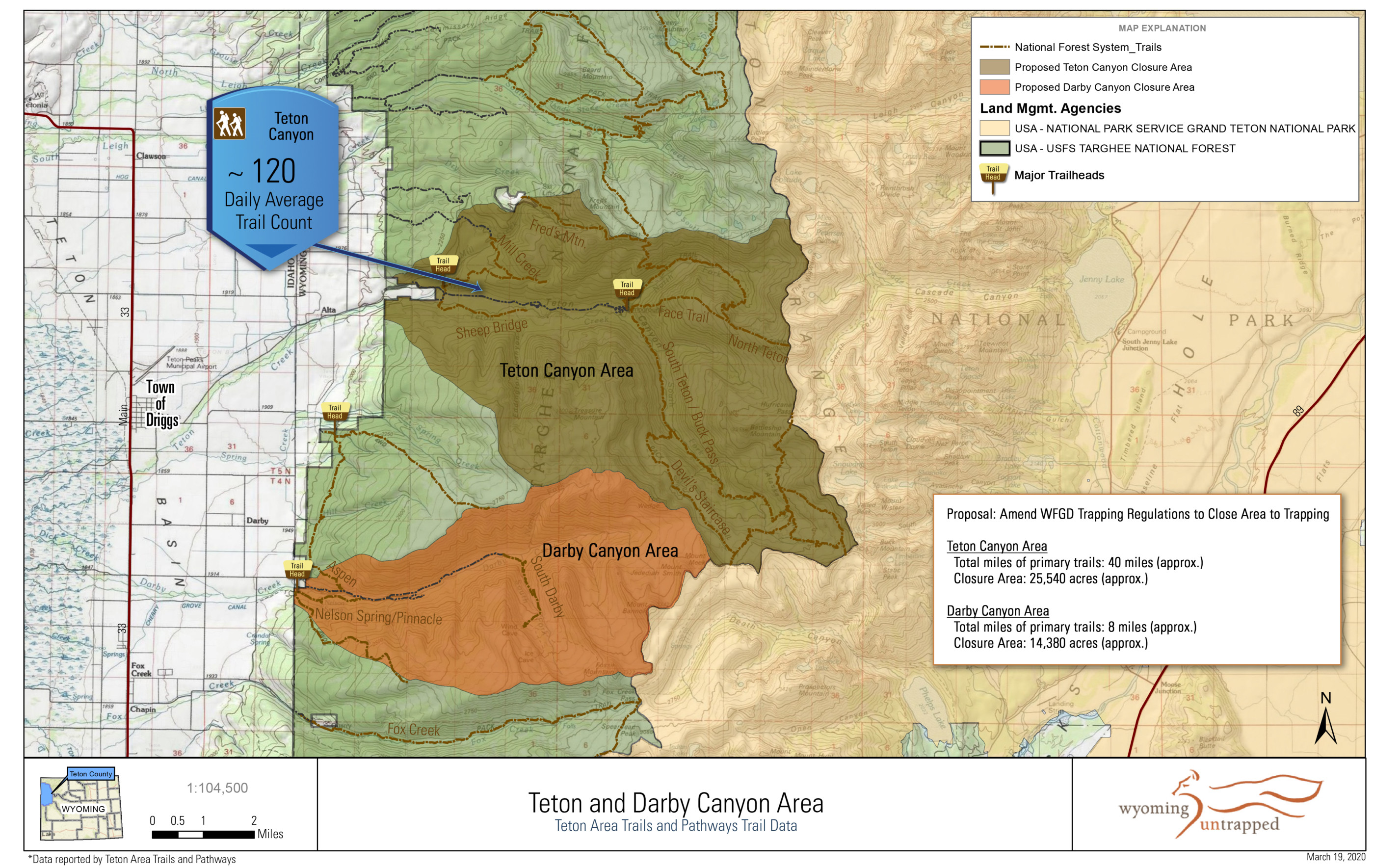
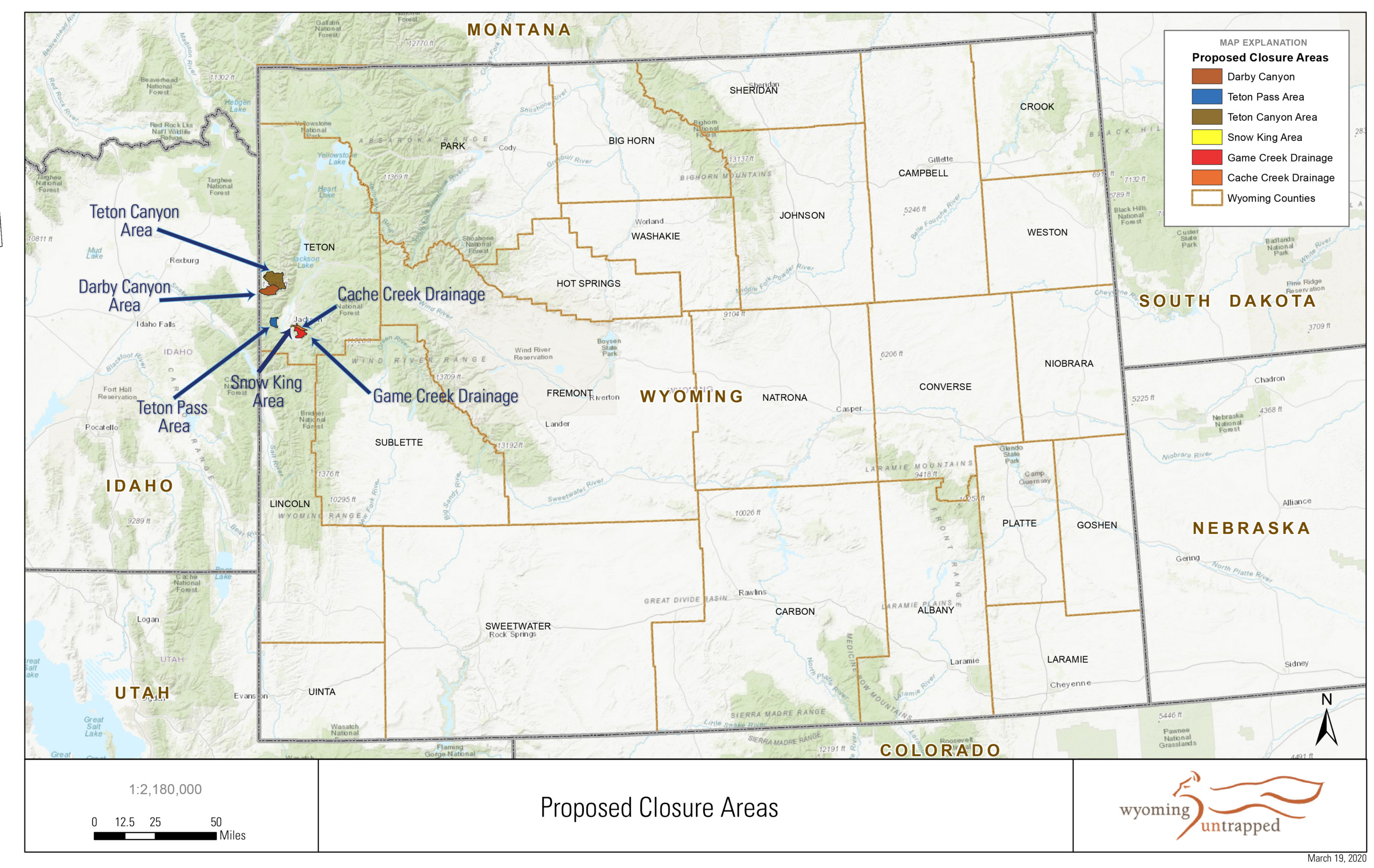

Cheryl Flowers
Please condemn trapping in your state. It is torture and a useless murdering of animals, when there are enough thinsetic fur, that we no longer need real fur. We need our wildlife it is created by God and is part of this planet. Please ban wildlife trapping as it is not safe. Anything can get caught in a trap
Wyoming Untrapped
Thanks for commenting, Cheryl. Would you also submit to WGFD online public comment? Thank you for the support!
Here is the link: https://wgfd.wyo.gov/Get-Involved/Public-Meetings
To submit public comment, deadline is Friday, June 4, 5pm.
Scroll down to: Chapter 4, Furbearing Animal Hunting or Trapping Seasons.
Then Submit Online Comment.
Lynne Coleman
Very disgusting to know the real monsters who’re humans having zero empathy for all beautiful animals God created for us to understand them, love them, respect them and their habitat homes, and be kind! Stop, stop, stop Pleassseee! They the real good souls, speaking of animals, never bother us in any evil ways!!!
Heidi Steinert-Bresilge
Use of these horrific devices need to be stopped!!!!!!!!! They are absolutely inhumane and can trap and kill anyone or anything unfortunate to come in contact with them!!!!! Unspeakable~ the torture, fear and pain that is experienced!!!!!!!!!
Juan Hernandez Garibay
Hunting, Trapping, killing wild animals is killing ECOSYSTEMS, this is pure cruelty against wild ANIMALS!!! We must put an end to this!!